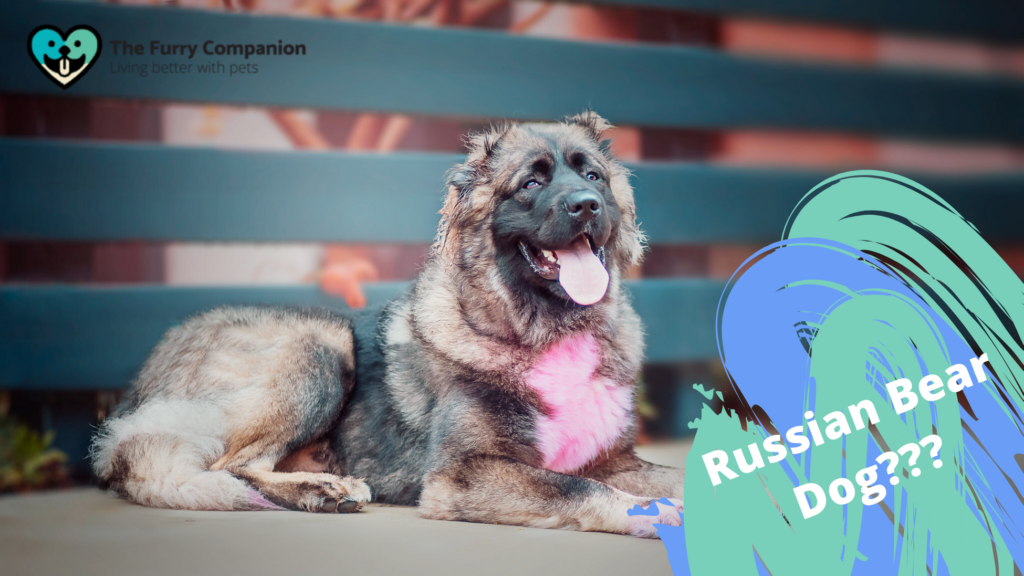With their bodies built for the dead of winter and their instincts out to protect, the Russian Bear Dog is one of the giant dog breeds perfect for guarding a herd. Although people have brought them into domestication, aspiring Russian Bear Dog owners should question themselves, “Am I bringing home a gentle giant or a leashed wolf?”
Find out if you should become this giant’s owner, as this mission isn’t for inexperienced owners. The Furry Companion shares with you interesting facts about this breed’s lineage, where to get one, and, importantly, how to take care of a titan. By the end of this read, we hope we helped you make your good judgment if you can handle the challenge as big as this собака. That means “dog” in Russian!
Table of Contents
From Russia With Love
Ancestors of the Russian Bear Dog hail from the Caucasus mountain range in Eurasia. They are descendants of great Molossers, famously known as a livestock guardian against predators in this mountainous area. These dogs have a sharp sense of scent and sight perfect for keeping a lookout for a flock of sheep. Interestingly, studies have shown that shepherd dogs like the Russian Bear Dog have genetic make-up of 10%.
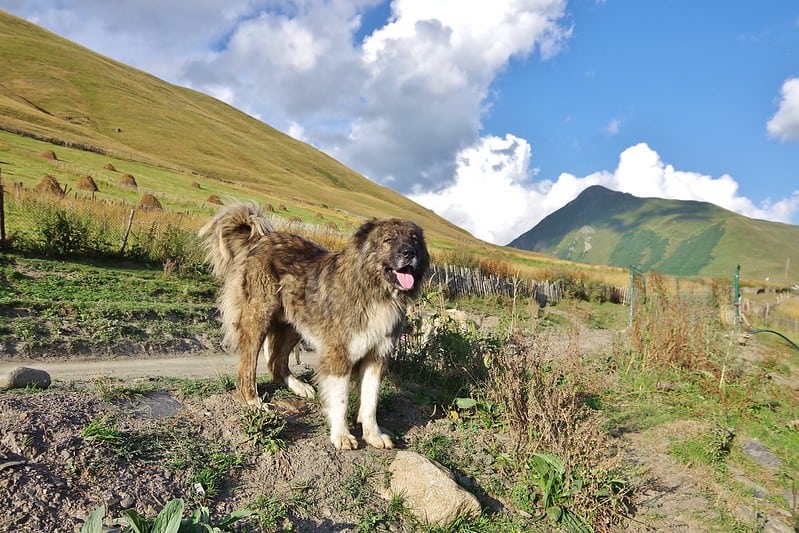
To this day, people in Georgia put Russian Bear Dogs as protectors. From discovering the Ovcharka’s fierce and robust character, Russia decided to recruit them as guard dogs for their banks and government facilities.
The Russian Bear Dog goes by many names such as Caucasian Mountain Shepherd or Mountain Dog. They are also referred to as the Caucasian Ovcharka. meaning “shepherd dog.”
A Russian Bear Dog’s Looks To Kill
Whatever you call them, Russian Bear Dogs have notably thick two-layers of fluff and fur to keep them warm in the coldest winters. They have a thick outer layer and a soft layer underneath. If you grow their manes out, it resembles that of a bear’s. Feathering fur can be found at the back of their legs and tail, too! Their uber-thick hair comes in different colors, from light shades like white, fawn, and cream to darks like black, grey, and a rusty red-brown shade. Often, they have dark facial masks.
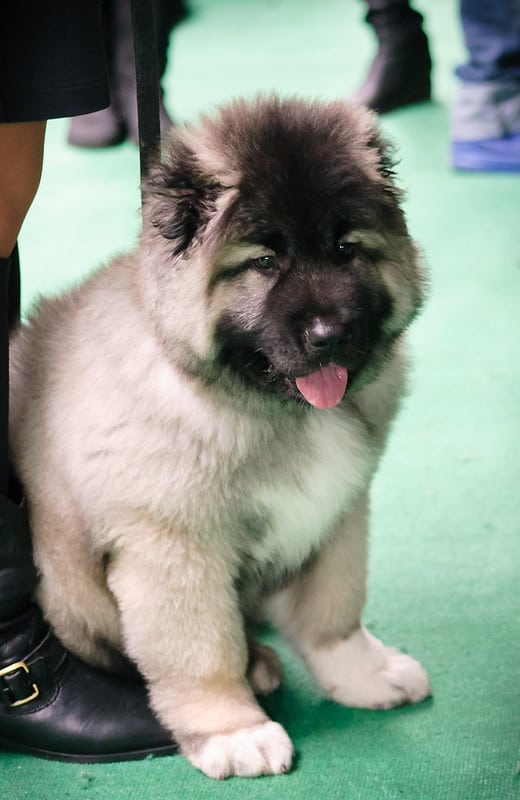
Russian Bear Dogs don’t precisely have “looks that kill”—perhaps “intimidating” looks describe them better. Warm brown, oval eyes sit atop their broad furry faces and powerful muzzles. Doggos like this have triangular-shaped ears on their heads. Caucasians traditionally crop their Ovcharka’s ears to keep wolves from biting and clinging onto them.
Russians wouldn’t have enlisted them as guard dogs if they didn’t see their muscular build and sturdy height as an advantage. A Russian Bear Dog has athletic short legs and large paws. Males can grow up to 200 lbs, while females can grow up to 180 pounds. As you can imagine, massive dogs like this can also grow up to 35 inches tall when on all fours.
The Russian Bear Dog Tamer
Now that we’ve sized up expectations, who do you think can tame this dog of a monstrous size? It may be a risk for inexperienced dog owners to aspire to take care of a Russian Bear Dog. Breeders suggest that they are for owners who can commit to quality time training and socializing with these pups. But, we believe if you have the heart and determination to take on this Goliath, give this giant a loving home! Check this durable dog leash for your dog.
A forewarning, though, Russian Bear Dogs might not be ideal for families with young children. Well, we can wait when the children are grown-up, can’t we? It’s probably worth the wait because behind that big, intimidating exterior lies a fluff ball of loyalty and love. They are very protective of their families. Strangers might find themselves running scared from the loud warning barks of an Ovcharka.
Unlike Pooka, Anastasia’s tiny dog companion, a Russian Bear Dog is strong-willed and independent. They are majestic and well-balanced creatures who don’t bark as much—until they feel threatened, that is. As Pooka is spirited, these shepherd dogs are not so hyper. On the contrary, with their stern looks, they can be described as stoic dogs with low activity levels. However, these furry titans are ready to spring into action when their flock or family is in danger.
An Ovcharka’s Master Checklist
Imagine how much time, effort, and money it requires to take care of a tiny lapdog you can easily fit in your purse. With that estimate in mind, you can already expect how much more it will take to care for a 200-pound Caucasian Ovcharka. The Furry Companion encourages aspiring Russian Bear Dog owners to be very well-prepared for the tall order it takes to become one’s master. In this section, we want to help hopeful furry parents size up their readiness with a quick checklist for the best interest of our Caucasian Shepherd doggies.
Are you ready to feed a village?
Okay, that might have been an exaggeration. The amount of food needed to feed a Russian Bear Dog depends on the size, age, and activity level of the furball. On an estimate, owners can feed them 8 to 10 cups of their favorite dry dog food, which they can split into two or three meals throughout the day. If you wish to feed them twice a day, one in the morning and another in the evening is ideal.
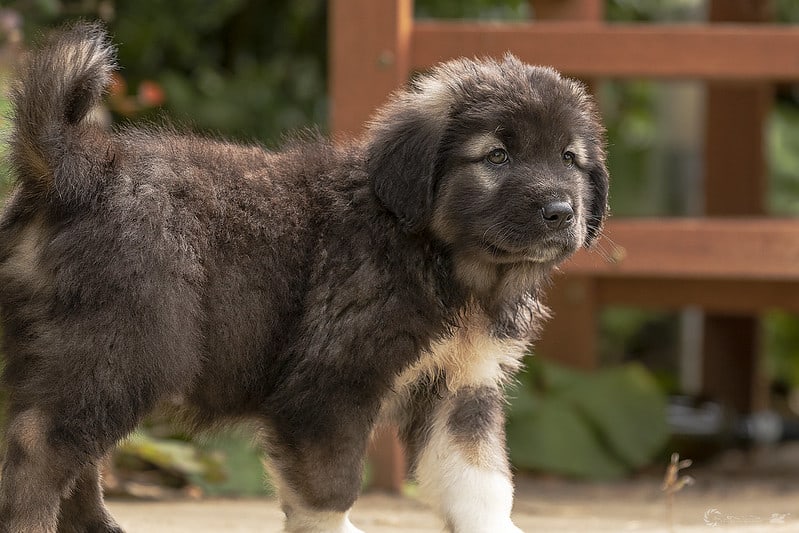
Since Russian Bear Dogs are not so active, owners should also look out for their diet. Do not feed your Goliath dog too much—they may become overweight or develop digestive problems like bloating. You can administer a check-up by checking your dog’s waist underneath all that fluff. An obese Russian Bear Dog may also develop bone problems because of overfeeding. To avoid obesity and weakened bones, serve your dog with calcium-rich dog food.
In this light, you may also need to become a strict dietician for your furry baby’s health and well-being. This canine’s lifestyle expects a luxury like no other as their dog food should be of high quality. And while we’re on the subject of dieting, please make sure you do not feed your Russian Bear Dog with food containing artificial ingredients and fillers like corn syrup. These ingredients are harmful to your dog’s health. This diet might be good for you, too! We know your dog may want some company.
It is also important to note that puppies should be fed with the same dog food by their breeders. Young stomachs are sensitive and easily upset. However, it is possible to train them through gradually introducing the new dog food into their diet. Make sure to check in with your vet before you do so!
Ryan Llera, BSc, DVM and co-authors say “The best strategy for feeding your dog well is to partner with your veterinarian and the veterinary healthcare team and start by performing a nutritional assessment.” Check this dog house for your pet.
Do you have a knack for exercise?
If you don’t need a diet buddy, maybe you would like to be your Russian Bear Dog’s exercise companion! Even though they are relatively low-energy pups, there is still a high risk of obesity. Regular exercise and play are essential for this breed. Some playtime suggestions Russian Bear Dogs would love are a good game of fetch. Likewise, with their strong endurance, an Ovcharka also enjoys long walks in freeing spaces like parks.
However, always put your pooch on a leash. Their size is intimidating enough, so people might just feel uncomfortable seeing them off-leash and trudging toward them in the park. Also, putting them on a leash will establish a sense of command.
Other bonding activities you can do with your Ovcharka are hiking, trekking, and other outdoor pursuits. Russian Bear Pups have so much energy, so better train your cardio! From puppyhood to adulthood, this breed needs an active master to accompany them on their adventures.
According to Robin Downing, DVM “Just like humans, dogs derive health benefits from regular exercise. An important aspect of facilitating, enhancing, lengthening, and strengthening our relationships with our canine companions is to keep them strong and fit through physical activity.”
Do you like your space?
We ask this question because, obviously, a creature of this size needs all the space you can give! Remember, Russian Bear Dogs are working dogs who need enough room to move about freely. Just like you, they like to move around and do productive exercises, too. If you live in a cramped apartment in the city, you may want to reconsider your choice of having a Russian Bear Dog live with you. “The comfort of a familiar bed or crate can be helpful, ” Debbie Stoewen DVM, MSW, RSW, PhD and collaborators add.
Did you ever consider opening a pet grooming salon?
Russian Bear Dogs wish to have masters who know how to keep their manes shiny and fabulous! This high-maintenance two-layer coat can’t clean itself. Woofers with short fur may be easier to maintain compared to long-haired dogs who need brushing every day. Daily fur-brushing with a fine-toothed comb is necessary to untangled and tame a Russian Bear Dog’s lush fur.
Their fur plays a vital role in regulating temperature. Whether in extremely cold or warm climates, you can expect that a Russian Bear Dog can adapt. Ideally, this doggo’s hair shouldn’t be too short, or else we’d be exposing it to skin problems. Buy this easy-to-use grooming set for your dog.
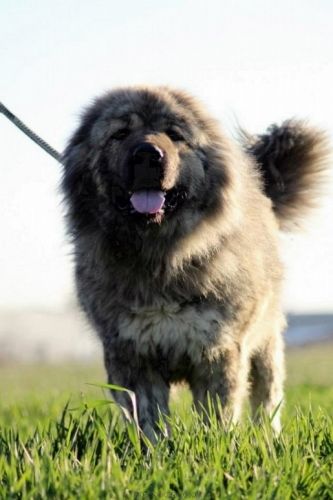
We all know dogs don’t aren’t so fond of b-a-t-h-s. When it comes to this part of doggie hygiene, it is only practical to do so when needed. We suggest washing them once or twice a month to keep them clean. If you don’t want to bring them to the groomers because you have a salon at home, prepare your supply of shampoos by the bulk!
Russian Bear Dogs shed their fur coat every year. Breeders call this heavy shedding as blowing coat. They typically shed their layers to adapt to new climates. To help your dog through this process, a warm bath and twice-a-week brushing can help shed the old coat faster. It is crucial to know that their fur is not hypoallergenic, so those of you allergic to animal dander better think twice.
Other important hygiene reminders for Russian Bear Dog owners include brushing your dog’s teeth two to four times a week, cutting their nails to avoid ingrown, and checking if their ears are dry and clean to prevent infection.
Do you consider yourself an alpha-type of person?
Russian Bear Dogs are not for the faint-hearted. This strong-willed and intelligent creature needs a thorough training program. Their strong will sometimes translates to hard-headedness as they are too smart for their own good. Now, what they need is an equally strong and determined master at keeping them in line. Start them young at puppyhood, around seven to eight months, as training is a lifetime process. It will be easier to build good habits while they are smaller than you.
It’s challenging to train independent and confident dogs like the Caucasian Ovcharka. Experts note a useful approach that works effectively with all kinds of dogs is positive reinforcement. Never punish them or show any aggression toward them. They will instinctively fight back and might just sit on you while they are at it.
Another approach essential to Russian Bear Dog training is operant conditioning. This teaching style inspires your dog to repeat the desired behavior due to the positive consequences offered. Establish leadership before and after your sessions, start leash training early, and keep training with stubborn dogs short. To help make the sessions fun and exciting, use their favorite toy in the exercises. You can identify what their favorite toy is by scattering all their toys and observing which toy they go to and pick up first. Of course, never forget to reward them with affection and praise for good behavior!
If you are thinking of enrolling them in obedience school to train with other dogs, we’ll stop you here. It is advisable to train them individually because they don’t do well with strange dogs and people. Get the best out of your training time by doing it yourself. If you hire a trainer to do it, your dog might end up respecting the training more than they respect you. Successfully training a sharp and sizable bear dog with patience and dedication are essentials. Owners need to prove to them who’s the real alpha dog!
Are you sociable?
If you are a friendly and affable individual, well and good. Your pup needs your social skills to rub off onto their lush mane. Since this breed isn’t a big fan of strangers, they have a small circle of trust. Russian Bear Dogs consider people and animals outside their circle as threats. By practicing socialization with them, we are teaching them that not everything is dangerous. Persistently train them to socialize by creating positive experiences when introducing them to other dogs, people, and, for extra aggressive dogs, other objects.
The tricky part of socialization training is monitoring your dog’s progress. Russian Bear puppy dogs may have a more carefree and friendly nature, but as they grow older, they become wary of new people. Therefore, never punish your dog as they will think this cruelty applies to all people. Regularly check the progress of your dog. See if they are ready to go out to parks after they’re comfortable with playing with the neighborhood’s big dogs.
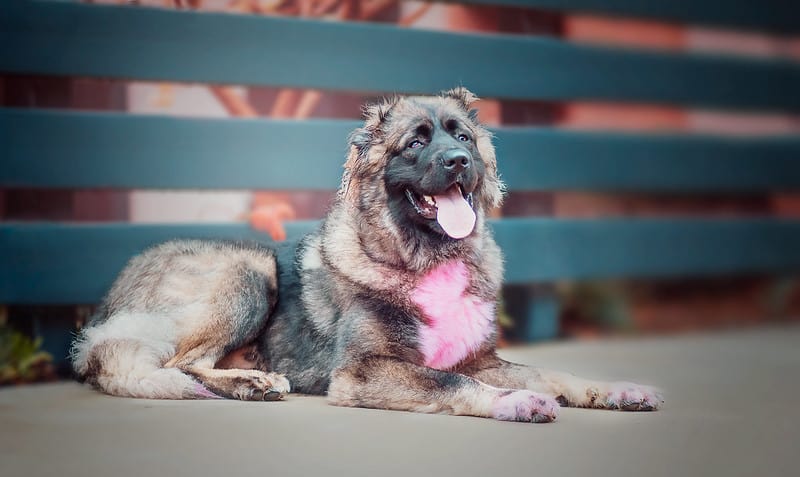
Are you health-conscious?
You would think big-bodied dogs like this are invincible. However, it turns out their health is also susceptible to the following conditions:
- Eye issues relating to cataract build-up
- Elbow and hip dysplasia
- Luxating patella or trick knee
- Heart conditions
Some of these conditions are genetic because of years of inbreeding. The best way to prevent these health conditions from arising is to have transparency with the breeder about the puppy’s parents. When you are better informed, you can look out for your pup better and watch out for them when they go down the stairs or start rough-housing.
Challenge Accepted!
A confident dog needs an even more confident master. If your answers to these questions are a huge “yes,” you already have the right mindset of owning a Russian Bear Dog. You can live a happy and challenging time with your pup. They naturally have a life span of 10 to 12 years when they have an extremely dedicated carer.
Currently, there are no laws prohibiting the ownership of Russian Bear Dogs in America. You may head down to a trusted kennel, or find yourself a reputable breeder. You can find breeds like this priced at $1,000 to $3,000. Here’s a list of questions to ask before signing any papers.
- What kind of food has the puppy been eating?
- Have they socialized with other dogs?
- Can we have a genetic screening of the puppy’s parents?
- Has the pup been vaccinated?
To check whether the breeder is trustworthy, ask for the puppy to be seen with its mother. This act allows you to see them with the rest of the litter. Not only will it give you a good idea of the trustworthiness of the breeder, but observing the dog will also enlighten you on the puppy’s temperament and socialization skills.
The Verdict
This breed of dog reminds us of a quiet guardian angel protecting you in silence. And like a mother bear to her cubs, she quickly springs into action when she senses danger. Russian Bear Dogs may not be ideal for herding sheep, but their hardworking and reliable character places them as the best guard dogs. Once you get to know them more, they are warm and fuzzy giants capable of giving you constant bear hugs!
Russian Bear Dogs are challenging to tame. On the other hand, positive training and socialization, a loving and spacious home, and a healthy lifestyle can transform these lone wolves into gentle giants. Being the companion of a Russian Bear Dog is no easy feat. You need to channel your patience and effort into helping them grow, and in the process, you also grow with them.
Frequently Asked Questions
Are Russian bear dogs legal in the US?
No specific laws are prohibiting Russian bear dogs into the United States. The reason behind this might be because these mountain dogs are relatively new in the country.
What breed is a Russian bear dog?
The Russian bear dog came from the breed of Caucasian Mountain dogs. Their primary role is to guard their territory against wild animals. This breed is also known as Caucasian Ovcharka dogs.
Are Russian bear dogs good pets?
The Russian bear dogs are very affectionate and loyal to their humans. These dogs are also very kind towards their family. They are suitable protectors, and so they make excellent guard dogs. However, their size may become a threat to young children, especially when they become too aggressive.
How much do Russian bear dogs eat?
Because of its size, the Russian bear dog requires the right amount of food. On the average, they consume 20 calories per pound per day. A puppy Russian bear dog needs around 9.7 grams to 12. 5 grams of meat per kilo of body weight per day. Meanwhile, a grown Russian bear dog needs less at 2.62 grams per kilo of weight.
Do Russian bear dogs shed?
Yes, Russian bear dogs do shed once a year to grow new fur. Russian bear dogs are among those breeds with a double coat, so it is not advisable to trim their coat.
How much is a Russian Caucasian Mountain Dog?
The Russian bear dog may cause a hefty amount because of its size. The average price for this dog is about $1000 to $2000. The cost varies depending on the breeder.
Is Caucasian dog dangerous?
The Caucasian dog or commonly known as the Russian bear dog is not dangerous by nature. However, because of their strength and size, they tend to be scary, especially when they are aggressive.
What age do Caucasian shepherds stop growing?
Dogs typically cease growing by the age of 12 to 18 months old. By this time, they are already fully grown to their size. But some larger breeds take even longer than this.
Is a Russian Bear Dog a family dog?
A Russian Bear Dog is loyal to its family and is deeply attached to its owners. They are excellent guard dogs for your family and their instinct is to protect their parents. However, their sheer size and strength can be a challenge, and they can become unstable. Despite the fact that they would not be intentionally aggressive against a family member, their overwhelming size can be frightening to children. Thus, they may not be a great option as a family’s first pet, especially those with small children.
Are Russian bear dogs easy to train?

